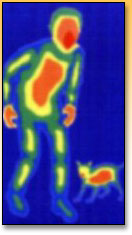MOTION
DETECTORS
 Motion
Detectors view an area watching for
"INFRARED"
changes, detectors view rooms, people
and animals differently -- similar
to this Motion
Detectors view an area watching for
"INFRARED"
changes, detectors view rooms, people
and animals differently -- similar
to this
The detectors basically view the room
“thermally”,
when you walk into the room you change
the “Thermal Picture”
that the detector is viewing.
Depending on the quality of the detector
and design, certain detectors can
tell the difference between say a
small dog and a child though different
radiated Infrared signals from each
of them.
Passive [Waiting for a change to
be transmitted to them from your radiated
infrared energy] detectors are sometimes
susceptible to air drafts, reflected
light from pools in their view, crawling
insects.
Microwave type detectors are Active,
which means they transmit their own
signals, these signals then bounce
back to the detector and the microprocessor
then analyses the received signals
and looks for changes. Microwaves
generally aren’t affected by
air draft movement – only solid
objects. Microwaves have to be carefully
placed though as they can also see
through Glass and other objects whereas
Passive type detectors don’t.
 STANDARD:
STANDARD: |
| |
Generally No Airdrafts,
Crawling/Flying Insects, Birds
and generally for sealed rooms
|
 PET IMMUNE:
PET IMMUNE: |
| |
Tell the difference between
say Cats/Small Dogs and Humans
|
 QUAD:
QUAD: |
| |
These basically have 2 standard
type sensors built into one housing,
although the sensor element [Pyroelectric]
has a different geranium filter
and is a dual element, thus having
two dual elements equals a Quad.
The 2 elements are slightly apposed
to each other. This slight offset
means the individual elements
don’t see exactly the same
movement creating a better false
alarm resistance – Ideal
for most situations as is more
tolerant to environmental changes
and some are immune to insects.
|
 DUAL:
DUAL: |
| |
This is usually a Standard Sensor
and a Microwave built in as well,
both technologies need to be activated
before the detector will activate
the alarm. In an harsh environment
situation remember that some only
have a Standard Pyroelectric with
the microwave which could make
that part of this dual technology
always in an "active"
state if placed in say a drafty
environment leaving all the detection
still back on one method being
the microwave.
|
 ANTICLOAK:
ANTICLOAK: |
| |
This is a New Technology that
should someone accidentally or
deliberately block the detector
by say placing a box in front
of it, the detector can still
see through the box and pick up
moving objects. The technology
is a lot more indepth than can
be explained here.
|
 ANTI
MASKING:
ANTI
MASKING: |
| |
This type of detector can be
programmed to look for movement
during a defined period, say 24
hours. If it doesn’t pick
up movement in this time is activates
a trouble alarm to advise you
to investigate the detector.
|
 ANTI
SPRAY:
ANTI
SPRAY: |
| |
Should someone try to block
the detector when the security
system is turned off with a spray
of some description, there is
an inbuilt sensor that can detect
this. Caution for the owner of
these detectors as normal surface
spray can also cause them to go
into alarm.
|
 WIRELESS:
WIRELESS: |
| |
There are a lot of wireless
detectors on the market which
communicate to the alarm panel
via a wireless transmitter and
receiver. The detector obtains
its power from a long life lithium
inbuilt battery. Any Quality wireless
detector should have a supervised
signal, this means it sends like
a “Test” to the alarm
panel at certain times and the
alarm panel looks for this signal
to make sure the detector is still
functioning [usually 1 hour].
The detector should also be able
to transmit Tamper Alarms, Low
Battery and of course intrusion
detection. Average battery life
depends on the Quality of the
detector, most range up to 3 years
or so. |
|